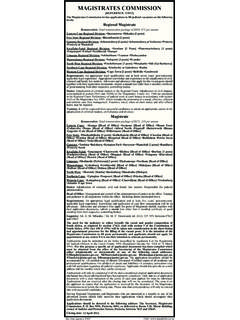Transcription of PSYCHEMEDICS - bnsf.com
1 PSYCHEMEDICS C O R P O R A T I O N GENERAL Hair testing analyzes for drugs within the hair shaft, rather than body fluids like urine or saliva, to determine whether drugs of abuse are present. Compared to analysis of body fluids, hair testing is highly resistant to evasion by adulterating or substituting samples, or by simply abstaining from drug use for a few days. PSYCHEMEDICS patented method for detecting drugs in hair uses immunoassay and state-of-the-art GC/MS/MS or LC/MS/MS confirmation to measure the drug molecules and metabolites permanently entrapped in hair which were incorporated following ingestion.
2 This technology offers significantly greater detection ability than other methods of analyzing hair or body fluids. Thousands of corporations use PSYCHEMEDICS test to screen applicants and perform random drug tests on their employees. Schools have been using the PSYCHEMEDICS test since 1997 to help their students stay drug-free. Courts routinely use the PSYCHEMEDICS test in their probation, parole, and diversionary programs. The use of hair is well established, and PSYCHEMEDICS has been conducting hair tests since 1987. Cocaine, Marijuana, Opiates (including Heroin, Codeine, Morphine, Oxycodone, Hydrocodone and Hydromorphone), Methamphetamine, Ecstasy (MDMA), Eve (MDEA) and Phencyclidine (PCP).
3 A standard test of one-and-one-half inches of head hair cut close to the scalp can provide a several month window to detect drug ingestion. Studies indicate that hair collected at the crown of the head grows on the average approximately cm (or inch) per month. This growth rate may vary among people; consequently the same length of hair may represent slightly different time periods. The primary difference is the wider window of detection with hair. Cocaine, methamphetamine, opiates and PCP are rapidly excreted and usually undetectable in urine 72 hours after use. Rather than the hours or days covered by a body fluid test, a hair test covers a period of months, ensuring that a drug user cannot evade the test by simply abstaining for a few days.
4 Additional advantages include: non-intrusive collection procedures, virtual elimination of test evasion through substitution or adulteration, and greater accuracy through test repetition capability. The combination of an increased window of detection and resistance to evasion makes hair testing far more effective than urinalysis in correctly identifying drug users. It takes approximately 5-7 days from the time of drug use for the portion of the hair containing that drug to grow above the scalp. In most situations the minimum time period is approximately one month. A hair test does not determine drugs used on a particular day or week.
5 What is the shortest time period that can accurately be evaluated? How soon after use can a drug be detected in hair? How does hair analysis compare to urinalysis? How fast does head hair grow? What time period does a standard test cover? What drugs are included in a standard test? Who is using hair testing? What is hair testing? Frequently Asked Questions Comparison studies have proven that the PSYCHEMEDICS test is up to 5-10 times more effective in identifying drug users than urinalysis. In other words, 85% of the drug users identified by a PSYCHEMEDICS test could get through a urine screen and enter the workforce.
6 PSYCHEMEDICS uses its patented digestion method to release virtually 100% of the drugs present for analysis, resulting in increased detection capabilities. Other laboratories may leach drug from the hair, leaving behind or destroying some of the drug in the process. PSYCHEMEDICS also employs an extensive wash procedure on test samples, and analyzes the wash to ensure that any potential contamination has been removed or taken into account. Other labs may use a less effective wash and/or do not analyze the wash, putting their clients at risk for making employment decisions based on a result that may be reflective of external contamination.
7 These levels are based on field studies that establish the presence of the drugs following ingestion. These levels are included in PSYCHEMEDICS FDA submissions, and are similar to the cut-off levels mandated in several state hair testing regulations and contained in the 2004 proposed SAMHSA mandatory guidelines. COLLECTIONS PSYCHEMEDICS standard screen, along with GC/MS/MS or LC/MS/MS confirmation, usually requires a cosmetically undetectable lock of hair preferably snipped from the back of the head, just below the crown. In general, the amount needed is the thickness of a shoelace tip. Hair analysis methods used by some other laboratories have required significantly more hair.
8 Yes. Hair can be collected from several locations on the head and combined to obtain the required amount of hair. If head hair is not available, certain body hair can be used as an alternative. No. For workplace testing PSYCHEMEDICS requires a hair sample to be collected using the proper chain-of-custody protocols that will withstand a legal challenge. PSYCHEMEDICS requires that the sample be submitted with PSYCHEMEDICS Sample Acquisition Materials. The test subject must initial the sample container to certify the authenticity of the sample at the time of collection. The collection process requires the collector only to take the candidate s natural hair.
9 Natural head hair or nape hair can be taken. Body hair can also be taken when hair from those two sources is not available. PSYCHEMEDICS provides detailed instruction through a written training manual and video. Both are available in English and Spanish. Additional help is available through Client Service Managers dedicated to each client, and from PSYCHEMEDICS professional trainers. SAMPLE CHARACTERISTICS Commonly used hair procedures ( , shampoos, conditioners, sprays, mousses and gels) have no significant effect on results. In fact, normal hair washing helps to remove external contamination. Normal hair treatments such as bleaching, perming and dyeing generally will not significantly lower the quantitative results.
10 If the protein matrix of the hair has been damaged to the point of Does chemical treatment of the hair affect the test results? What collection help can I get? How are collections performed on candidates that use artificial hairpieces or attachments to their own hair? Can hair collected from a brush be used? Can tests be run on people with little or no hair? How much hair is needed? How does PSYCHEMEDICS establish its cut-off levels? Is all hair testing the same? How sensitive is hair testing in detecting drug users? breaking (cortex damage), the level of drug can be significantly affected. However, severely treated or damaged hair can be readily identified from the wash ratios and/or staining procedure.














